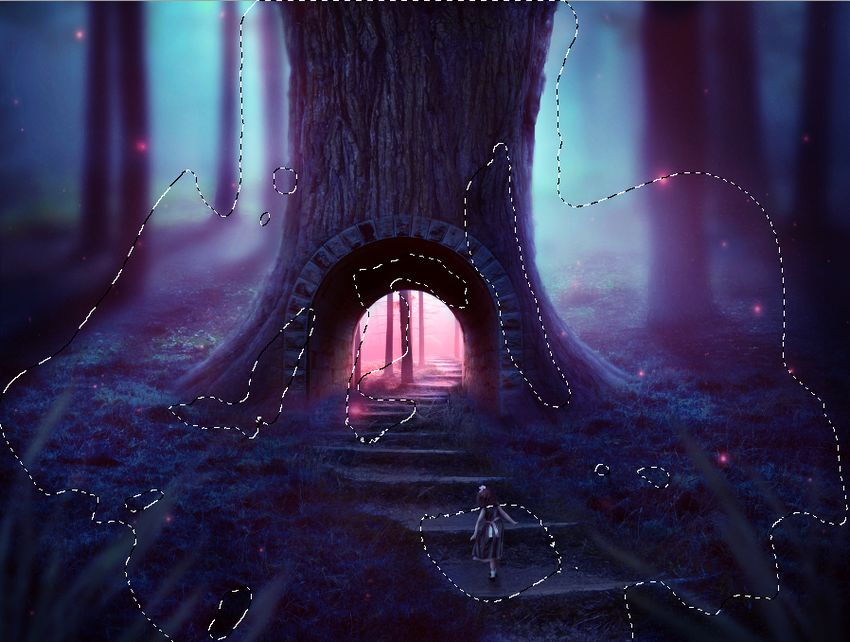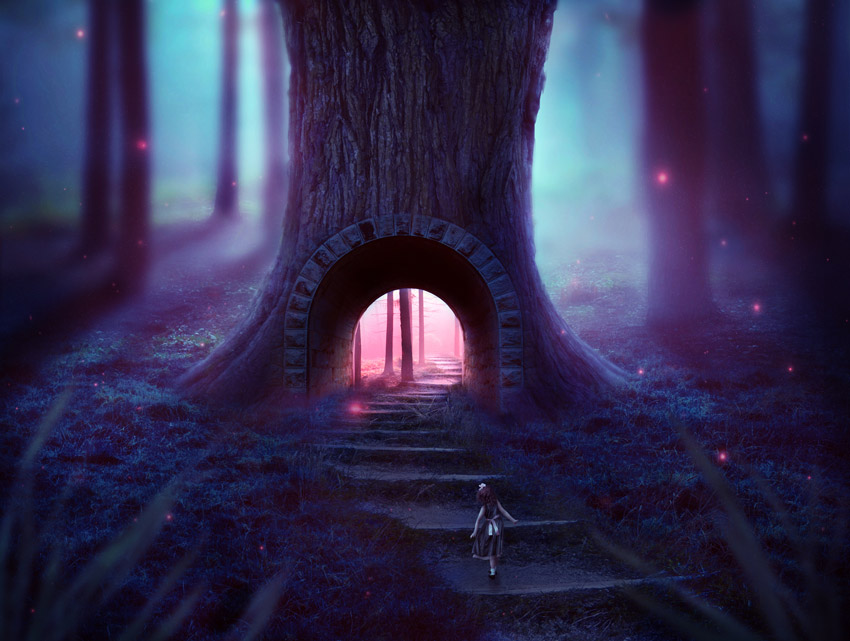An Interest In:
Web News this Week
- April 28, 2024
- April 27, 2024
- April 26, 2024
- April 25, 2024
- April 24, 2024
- April 23, 2024
- April 22, 2024
How to Create a Fantasy Photo Manipulation in Adobe Photoshop

In this tutorial I'll show you how to create a fantasy pathway scene. First we'll build the background from grassy ground and a forest. Later we'll add the tree, gate, small forest and pathway. After that we'll add the child and grass, and we'll make the basic light and color. Finally we'll add the light texture and make some lighting effects.
Tutorial Assets
The following assets were used during the production of this tutorial:
1. Build the Background
Step 1
Create a new 1800 x 1357 px document in Photoshop with the settings below:

Step 2
Open the ground image. Use the Rectangular Marquee Tool (M) to select the
grass area only and move it to the white canvas using the Move Tool
(V). Place it in the lower half of the canvas:


Step 3
Go to Filter > Blur > Gaussian Blur and set the Radius to 30 px:

Select the filter mask and use a soft round brush with black color (soft
black brush) to erase the blur effect in the foreground:

Step 4
Go to Layer > New Adjustment layer > Hue Saturation and set it as
Clipping Mask. Change the Master Saturation, Reds and Yellows values:


Step 5
Create a Curves adjustment layer and reduce the lightness. On this layer
mask, use a soft black brush to reveal some light on the background:


Step 6
Drag the forest image into our main document and place it in the upper half:

Use a layer mask to make a smooth transition between the ground and the forest:

Step 7
Apply a Gaussian Blur of 12 px to the forest. Use a soft black brush on the filter mask to
reduce the effect along the transition between the ground and forest. Here
are the results on the filter mask and on the picture:



Step 8
In this step we'll make shadows for the trees in the forest. We aim to
make the main light source come from the middle of the forest so the
shadows of the trees must be more visible. Create a new layer and use the
Polygonal Lasso Tool (L) to select the big tree on the right (no need to
be so precise) and fill it (Shift-F5) with black .

Flip it vertically (Edit > Transform > Flip Vertical) and move it
under the tree. Use the Free Transform Tool (Control-T) to distort the
shadow to fit the light direction:

Apply a Gaussian Blur of 15 px to this shadow:

Step 9
Use the same method to make shadow for the other trees:

Step 10
Create a Curves adjustment layer on top of the layers and increase the
lightness. On this layer mask, use a soft black brush to make the light
effect visible only in the middle of the background:

Step 11
Create
a new layer and change its mode to Soft Light 100%. Use a soft white
brush to paint more light for the middle of the forest.

2. Add the Tree
Step 1
Isolate the tree and add it to the midground. Use Control-T to decrease the length a bit.

Use a layer mask to remove the hard edges and blend the tree with the ground:

Step 2
Apply a Gaussian Blur of 4 px and erase the blur effect on the filter
mask, leaving it visible only on the tree contour to fit the softness of
the background:

Step 3
Create a new layer, change the mode to Overlay 100% and fill with 50% gray:

Activate the Dodge and Burn Tool (O) with Midtones Range, Exposure about
10-15% to brighten the tree contour and darken the middle a bit to fit
the light and shadow of the background. You can see how I did it with
normal mode and the result with Overlay mode:

Step 4
Use a Hue/Saturation adjustment layer and bring the Saturation value down to -62:

Step 5
Make a Color Balance adjustment layer and change the Midtones settings:

Step 6
Use a Curves adjustment layer to darken the tree. Paint on the tree contour to reveal the lightness there:

Step 7
Create a new layer and use a soft white brush with a low opacity (about
15-20%) to paint along the tree contour to make some hazy light on
there.

3. Add the Gate and Small Forest
Step 1
Open the gate image. Remove the part inside the gate and add it to the bottom of the tree:

Use a layer mask to blend the gate with the tree.

Step 2
Create a Color Balance adjustment layer and change the Midtones values:

Step 3
Make
a Curves adjustment layer and change the lightness of the gate to fit
the tree. Erase the lower parts as shown in the screenshot below
because we aim to add another light source there:

Step 4
Duplicate the forest layer and make it much smaller. Set this layer under the gate layer and above the tree ones.

Use a layer mask to remove the forest part outside the gate.

Step 5
Make a Curves adjustment layer to increase the light and haze of this small forest:

4. Add the Pathway
Step 1
Select the pathway from the original image and place it in the
foreground. Use Control-T withWarp mode to bend the pathway a bit.

Step 2
Remove the edges of the pathway using a layer mask:

Step 3
Duplicate this layer twice and resize them down. Arrange them inside the gate and the small forest. The further away they are, the smaller they should be.

Step 4
Select all the pathway layers and press Control-G to make a group for
them. Change the group mode to Normal 100%. Create a new layer and use the Clone Tool (S) to remove the unwanted plant shown on a step of the
pathway.

Step 5
Use a Color Balance adjustment layer to match the pathway color with the scene:

Step 6
Create a Curves adjustment layer to darken the pathway as it looks too
bright compared with the background at the moment. Paint on the top of
the pathway (the part inside the gate and small forest) in order not to change its
lightness.

Step 7
Add another Curves adjustment layer to increase the hazy light of the pathway top. Erase the rest to make it still dark.

5. Add the Child
Step 1
Cut out the child and place her onto the step on which we removed the unwanted plant.

Step 2
Make a new layer under the child one and use a medium-soft black brush
with a low opacity (20%) to paint a shadow for her. The child is far
from the two light sources so the shadow should be very light and soft.

Step 3
Add a Hue/Saturation adjustment layer and reduce the Saturation value to -38:

Step 4
Use a Curves adjustment layer to darken the child. Paint on the parts which are towards the light (the front) and keep the others dark.

6. Add the Grass
Step 1
Open
the grass images pack. As the images have a transparent background, simply move them into our main document and arrange them on both
sides of the lower foreground:

Step 2
Apply a Gaussian Blur of 8 px to each of these grass layers.

Step 3
Make a group for these grass layers and use a Hue/Saturation adjustment layer to change their color:

Step 4
Use a Curves adjustment layer to darken the grass a bit. The selected areas show where to paint on the layer mask.

7. Make the Basic Adjustment
Step 1
Create a Color Fill layer on top of the layers and pick the color #160101. Change this layer mode to Exclusion 100%:

Step 2
Make a Color Balance adjustment layer and alter the Midtones and Highlights settings:


Step 3
Add a Channel Mixer adjustment layer and change the values of the Red channel:

Step 4
Create a Curves adjustment layer and change the color a bit with the Blue channel:

Step 5
Use another Curves adjustment layer and increase the light in the middle. Paint on the rest of the scene:

Step 6
Continue changing the color with a Hue/Saturation adjustment layer:

Step 7
Make a Photo Filter adjustment layer with the same purpose. Pick the color #01ec96:

Step 8
Make a Vibrance adjustment layer to enhance the whole effect. Reduce the
saturation on the tree and the pathway on its layer mask to make them less blue.

8. Add the Light
Step 1
Open the light texture image pack. Choose "starry 4" image to add it to the canvas, and change the mode to Screen 100%:

Use a layer mask and erase the effect on the tree, making it appear more subtle.

Step 2
Create a Hue/Saturation adjustment layer to change the light color from red to pink:

Step 3
We're going to change the color of the small forest to make it look like
another world. Use the Lasso Tool to select the small forest area with
the Feather Radius = 30. Go to Layer > New Adjustment Layer
> Channel Mixer:

Step 4
Make a new layer and use a medium-hard brush with the color #ffadc4 to
paint the pink/purple light reflection from the small forest on the gate and the steps of the pathway which are located inside this forest.

Step 5
Use a Curves adjustment layer to change the light and contrast of the
whole scene, darkening the edges and leaving the light in the middle.


Congratulations, You're Done!
I hope that you've learned something useful for your future projects.
Feel free to leave your comments in the box below—I'd love to see them.
Enjoy Photoshopping!

Original Link:
TutsPlus - Design
 TutsPlus+ is a blog/Photoshop site made to house and showcase some of the best Photoshop tutorials around.
TutsPlus+ is a blog/Photoshop site made to house and showcase some of the best Photoshop tutorials around.More About this Source Visit TutsPlus - Design

